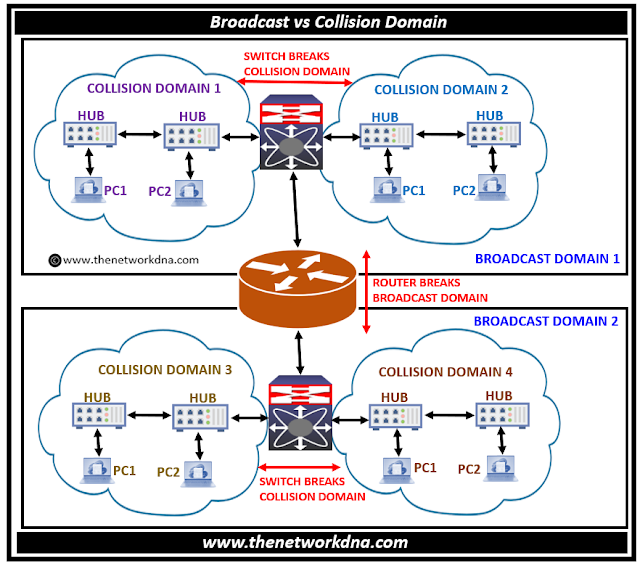CCNA R&S Article #1 – Broadcast vs Collision Domain
Broadcast vs Collision Domain
Today let’s talk about two terms – Broadcast Domain & Collision Domain. These two are overused in the CCNA course and understanding these two will help to grasp why routers & switches are used in a network. Simple but worth reading!Broadcast Domain – an Ethernet term used to describe when a
user is transmitting, all other users must pay attention to it and process it. Broadcasts
in a network are useful but excessive broadcasts (Broadcast storms) are not
good for any network.
Collision Domain – it’s an Ethernet term used to describe a
network setup where one user sends traffic and other users observe it. If two
users send traffic simultaneously, a collision happens and both users need to
retransmit data.
Local Area Network
Figure 1 shows the basic LAN setup using the HUB. You can
see two users (Sohan & Mohan) are connected to this using a set of wires. The
below network is an example of one Collision Domain and one Broadcast Domain.
For a home network with few hosts, this looks simple but
life in a large network (Enterprise Setup) is not that simple and needs more
configuration and setup of security in place to make things work.
Figure 1:
Basic LAN Setup
When a large network uses the Hub as an aggregate for
connectivity of multiple users, a large collision domain and broadcast domain are
built which is not good for user productivity. With so many broadcasts and collisions
this network cannot sustain running that latest applications that are
transactional.
Switch & Router Role
Figure 2 shows a LAN with Switch added to it. We can say
this network has two segments one with Hub & another Segment is users
connected to the switch. When we build a network using switches (layer 2), each
port represents to a separate collision domain on the switch. It means multiple
users can send traffic same time [more users are productive and adding value to
the organization]. From a networking point of view switched networks (where
switches are used) are less noisy compared to one built using Hubs.
So things are better here. For example, if Sohan is sending
traffic, Mohan to pay attention to it as both are on the same collision domain
[both are connected to Hub]. However, it does not bother Geeta she will
continue to work without any attention to the data sent by Sohan. However, if
there is a broadcast by Sohan on the network, it will need to be processed by
both Mohan & Geeta in this scenario as it is still a broadcast domain.
Broadcast Domains = 1
Collision Domains = 2 [1x for users/devices connected to Hub
& 1x for every connected port to Switch]
Figure 2:
LAN Segment with Switch
A large Broadcast Domain is a problem in any network as it causes
unnecessary congestion that may overload our network – which in turn slows down
everyone on the network. Let’s highlight some of the key reasons that add
congestion to the network –
- Large collision or broadcast domain with many hosts
- Excessive Broadcasts by devices – including ARP
- Excessive Multicast Traffic
- Poor connectivity using low bandwidth links
- Adding dumb devices like Hub
Figure 3 below is an improved version of the network in
Figure 2. We could clearly see in Figure 2, Hub doesn’t create a segment but
connect a segment. However, a switch creates a segment on every connected port.
Both the switches have 2 collision domains each – and as a router is introduced
in this network we have 2 broadcast domains. Routers in any network create
segments where broadcasts sent in one segment are not forwarded to another
segment. The router also breaks the collision domain. For example, let’s say
Sohan sends a broadcast, it will be processed by every device on the left
switch including Mohan. As the router is also connected to this switch, the router
interface also receives the broadcast but it will not be forwarded to the Switch
on the right side.
We have 4x visible collision domains and two broadcast domains
in the below network.
Figure 3:
Router Breaks Broadcast Domain
Note: the network in Figure 3 is just for illustration purposes
Large LANs are not built using routers. Generally, the router is used for
building the WAN (Wide Area Network).
In Figure 3, each device is connected to its own collision
domain (each Switch Port = 1 collision domain). And the router segmented the
network into two broadcast domains. So, Geeta and Sita are not disturbed by the
noise created by Sohan & Mohan as both are on different networks
altogether.
The main purpose of using layer 2 switches is to make a LAN
work better, optimize its performance, and provide more bandwidth (capacity to
send more data between hosts) to devices. Switches only switch frames from one
port to another within the switched network.
I hope you find this informative see you soon with another topic
– the difference between Routers and Switches.
Continue Reading...











